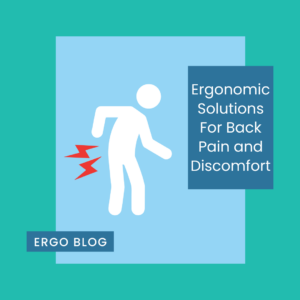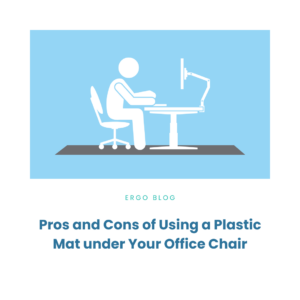Updated: Jan 26, 2023
Ergonomics for Sign Makers
Creating a beautiful image and product for other companies is what sign makers do best. However, the process of making this happen can involve an extensive amount of manual labor. No matter what industry we are working in, there are several ergonomic concepts to keep in mind to make sure we are taking the best care of our bodies to remain healthy in years to come.
3 Body Positioning Recommendations
- Maintain an upright and neutral posture. The goal is to keep a good posture by having the equipment, products, and supplies at the best height. When these items are positioned correctly, slouching, and increased neck flexion can be avoided.
- Keep your upper extremities in your comfort zone. When we reach outside of our comfort zone this causes additional muscle fatigue, strain, and discomfort in our backs, necks, and shoulders. Our bodies work most efficiently when our arms are by our sides and elbows bent at 90-100 degrees.
- Change positions frequently. Just like sitting for too long or engaging in a sedentary lifestyle can have negative effects on your body, so can standing for too long, crouching for too long, and forward bending for too long… you get the point. Any single position that is maintained for long periods of time taxes our muscles. This can lead to an increased risk of sustaining a soft tissue injury.
All of these body positioning recommendations first start with good habits. However, adding new habits to your daily routine takes time. While you are working check on your body positioning every 30 minutes. Check to make sure you are in a good posture with your back and neck straight and your shoulders back and down. Also, look at your arm and hand location to make sure you are not reaching out too far. Wrists should also be in a neutral position. Lastly, make sure that you have changed positions in the last 30 minutes. On average, it takes 2 months to implement new habits. 66 days to be exact. Be patient with yourself as you are adding these new habits into your daily routine.
Equipment Considerations
In order to meet the body positioning recommendations, there are many times when changes in the shop need to be made. Additional changes can help with the successful implementation of new habits as well.
- Install worktables at various heights. Completing the same job task by someone who is 5 feet tall versus someone who is 6 feet tall is going to require a different table height. Simply adding a turn crank height adjustable table to the shop may not be a large enough surface to accommodate the needs of various sized jobs. This is why the recommendation of different static worktable heights may be more beneficial.
- Use anti-fatigue mats. Install anti-fatigue mats in areas where sustained standing takes place. Avoid getting an anti-fatigue mat that is too soft or thick. Although it may feel great at first, in the long run, an extra soft mat may cause workers to work harder on maintaining their balance. Mats should not be placed in an area that is also considered a walkway as this could cause a tripping hazard.
- Sit down when able. A lot of the sign making tasks can cause a large number of movements and side stepping from one end of the project to another. If you are working on a small task, sit down to provide some relief. Finding a task stool with a backrest is ideal. Check to make sure that your legs are supported as well so your feet are flat with knees and hips at 90-100 degrees of flexion. Keep track of how long you are sitting or standing and change positions every 30 minutes. If sitting is an option, also be sure that there is adequate leg space so additional forward bending or trunk flexion does not occur.
- Illuminate areas of focus with additional lighting. When areas are not well lit our bodies tend to lean forward to see better which causes poor posture. Using lamps and other added light sources can help reduce eye strain and improve posture.
- Magnify small and detailed tasks. Using a magnifying lens that can clamp onto the edge of the table with a mobile arm can help keep hands free. There are additional magnifying lenses with light that would be beneficial as well.
- Build up the handles of small tools. Continuously holding a tool in a pincer grasp creates additional and unwanted pinching force. Foam handles can be added to small tools to increase the grip diameter which in turn decreases a sustained pinch force. Larger plastic handles can be added to squeegees as well to increase the grip surface.
- Add long handled tools to your toolbox. Especially when cutting. The process of cutting happens rather quickly and can create an awkward posture rather quickly. One option is to use a long-reach vinyl cutter to reduce reaching during cutting tasks.
- Find the right ladder for the given job. Use a podium step ladder to get to the needed height of the job while getting closer to the task. A podium step ladder will help to reduce extended reaching, even at elevated heights. When using an extension ladder, also add a ladder stabilizer to help keep the ladder secure. For larger jobs that require more space, setting up scaffolding may also be a good option.
- Stools can help with lower-level work. Instead of bending down, squatting, kneeling, or even sitting on the floor, consider using a shop stool to support a seated position. Having a stool with a tray below can help keep needed items close by.
- Use semi-automated or automated equipment. There are numerous equipment options available for sign makers to help reduce some of the manual job tasks. For example, a multipurpose applicator can help press vinyl onto a board which eliminates most, if not all, the squeegee needs for the given project. Having height adjustable legs helps to accommodate different workers and job sizes.
The final and most important recommendation I have is to implement rest breaks throughout your workday. This can be a stretch that is completed every hour, it could be a job rotation, a walk around the shop, or simply stop for a short period of time. Allowing your body to rest can help your muscles recover to maintain healthy habits throughout your day.
Check out our YouTube video below for a visual representation of the blog!



